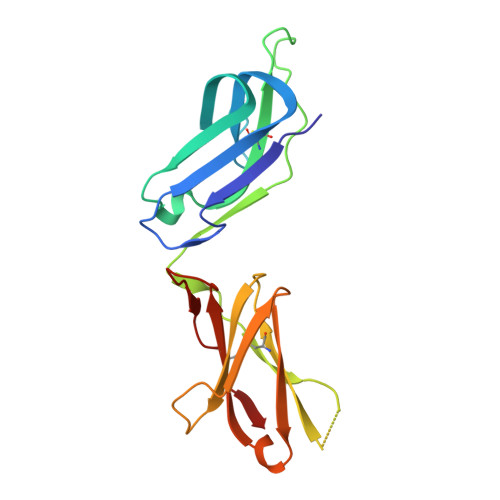Structural basis of collagen recognition by human osteoclast-associated receptor and design of osteoclastogenesis inhibitors.
Haywood, J., Qi, J., Chen, C.C., Lu, G., Liu, Y., Yan, J., Shi, Y., Gao, G.F.(2016) Proc Natl Acad Sci U S A 113: 1038-1043
- PubMed: 26744311
- DOI: https://doi.org/10.1073/pnas.1522572113
- Primary Citation of Related Structures:
5CJ8, 5CJB - PubMed Abstract:
Human osteoclast-associated receptor (OSCAR) is an immunoglobulin (Ig)-like collagen receptor that is up-regulated on osteoclasts during osteoclastogenesis and is expressed in a range of myeloid cells. As a member of the leukocyte receptor complex family of proteins, OSCAR shares a high degree of sequence and structural homology with other collagen receptors of this family, including glycoprotein VI, leukocyte-associated Ig-like receptor-1, and leukocyte Ig-like receptor B4, but recognizes a unique collagen sequence. Here, we present the crystal structures of OSCAR in its free form and in complex with a triple-helical collagen-like peptide (CLP). These structures reveal that the CLP peptide binds only one of the two Ig-like domains, the membrane-proximal domain (domain 2) of OSCAR, with the middle and trailing chain burying a total of 661 Å(2) of solvent-accessible collagen surface. This binding mode is facilitated by the unusual topography of the OSCAR protein, which displays an obtuse interdomain angle and a rotation of domain 2 relative to the membrane-distal domain 1. Moreover, the binding of the CLP to OSCAR appears to be mediated largely by tyrosine residues and conformational changes at a shallow Phe pocket. Furthermore, we investigated CLP peptides as inhibitors of osteoclastogenesis and found that a peptide length of 40 amino acids is required to ensure adequate inhibition of osteoclastogenesis in vitro. These findings provide valuable structural insights into the mode of collagen recognition by OSCAR and into the use of synthetic peptide matrikines for osteoclastogenesis inhibition.
Organizational Affiliation:
Chinese Academy of Sciences Key Laboratory of Pathogenic Microbiology and Immunology, Institute of Microbiology, Chinese Academy of Sciences, Beijing 100101, China;














